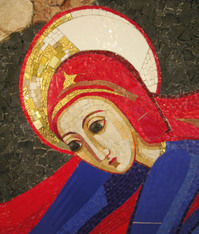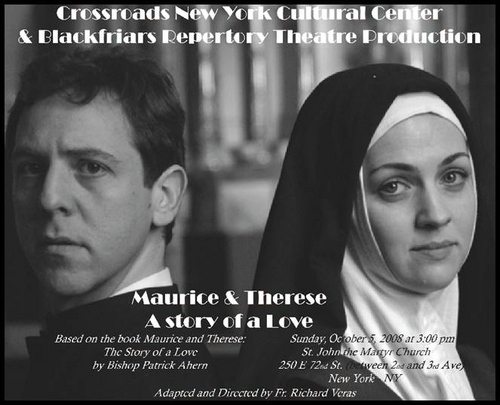The centuries of Catholic life reveal a variety of "violations" of the Eucharist, Holy Communion, the real Presence of our Lord and Savior Jesus Christ. These violations include heretical writings, sermons, plays, burnings, descration of the sacred Host, etc. Now we are dealing with technology's assistance in abusing the eucharistic Lord.
A problem we face is invinsible ignorance and flagrant behavior meant to shock and discourage the faithful. One of the disappointing things is the lack of media coverage on this topic and how relatively few Catholics standing up for their confessed faith in Jesus Christ. Of 65 million Catholics in the USA, how many are protesting this act of sacrilege? By protesting I don't mean shaking their fingers and heads and saying, "That's terrible!" but actually saying and doing something in a public way with friends, colleagues, etc. to make it clear that abusing something as sacred as the Communion is not to be tolerated.
In an era when religious sensitivity has lots of currency, even to an extreme, why isn't this a matter significant discussion and reaction from the Christians of all stripes? Here I take issue with a point in the article below: I don't see this act getting people mobilized to correct an abuse. Even though the other ecclesial communities who have some belief in Communion should stand up and demonstrate. Where are they??? Why aren't the Catholics as vocal as the Jews and Muslims are when they experience a preceived abuse of their theology? Think of the Danish cartoons that got Muslims excited.
Elizabeth Ela writes a piece for HeadlineBistro.com which is helpful. AND write to YouTube at the email address noted below to register your complaint.
 People can find a video of almost anything on YouTube: babies' first steps, Saturday Night Live skits, news clips, concerts and now - to the shock of Catholics everywhere - desecration of the Eucharist.
People can find a video of almost anything on YouTube: babies' first steps, Saturday Night Live skits, news clips, concerts and now - to the shock of Catholics everywhere - desecration of the Eucharist.
YouTube has long been a destination for Catholics seeking video clips of Masses, apologetics lectures or devotions, but now Catholic outrage is growing as the site has become home to a string of videos depicting acts of Eucharistic desecration, including flushing a host down the toilet, putting one in a blender, feeding one to animals, shooting one with a nail gun and more. "I don't know what to say," said a stunned Msgr. C. Eugene Morris, professor of sacramental theology at Kenrick Glennon Seminary in St. Louis, when told about the videos. "I am outraged that YouTube is tacitly supporting this and giving this behavior an audience."
The most prominent series of videos come from one YouTube user who claims to steal a consecrated host every day and desecrate each one in a different way. His videos began two months ago with the user saying into a webcam that he denied the Holy Spirit, then splitting a host in half and eating it with disrespect.
Most of the videos only have a few hundred views - relatively low for YouTube standards - although the latest installment, "Eucharistic Desecration #33: Nail Gun," has been watched over 1,000 times.
The user, who lists his first name as Dominique, has also posted a video of his receiving communion at an unidentified Catholic church and removing the host from his mouth in the church parking lot. Msgr. Morris said people need to "stand up" for their faith in cases like this. Some have taken up the challenge.
Thomas Serafin is president of the International Crusade for Holy Relics, an internet watchdog group of Catholic laymen. His group has been fighting online affronts to the Catholic Church, including the sale of the Eucharist and of relics of the saints online, for more than a decade. "YouTube has to be held accountable and stopped," Serafin said from Los Angeles. "If Catholics don't take a stand right now, they can expect such outrages to continue."
Serafin added: "The internet is, in many ways, a new world, and it is our duty to evangelize this world, but we have to speak up and be heard to do that."
YouTube's content policy technically restricts users from posting videos that contain hate speech or "shocking and disgusting" elements.
"We encourage free speech and defend everyone's right to express unpopular points of view," YouTube's Community Guidelines state. "But we don't permit hate speech (speech which attacks or demeans a group based on race or ethnic origin, religion, disability, gender, age, veteran status, and sexual orientation/gender identity)."
YouTube spokesperson Kathleen Fitzgerald asked for additional links to the desecration videos, but did not respond to a request for comment prior to the publication of this story.
However, YouTube defines hate speech as "content that promotes hatred against members of a protected group. For instance, racist or sexist content may be considered hate speech. Sometimes there is a fine line between what is and what is not considered hate speech. For instance, it is generally okay to criticize a nation, but not okay to make insulting generalizations about people of a particular nationality."
The guidelines add, "YouTube is not a shock site. Don't post gross-out videos of accidents, dead bodies or similar things intended to shock or disgust."
Users may "flag" offensive videos, which YouTube says will alert their reviewers to videos that may violate content guidelines. A video featuring the Eucharist desecrated with a knife was flagged by Headline Bistro staff but remains on YouTube.
"Here you have someone attacking another group, and there's no outcry," Msgr. Morris said. "We're not hurting anybody or attacking other's beliefs," he added, saying he would ask perpetrators of Eucharistic desecration, "Why are you so concerned about this? Why is it your business?"
One name still making the rounds in YouTube and bloggers' discussions on Eucharistic desecration is Paul Z. Myers, the University of Minnesota professor who asked his blog readers in July to "score" him "some consecrated communion wafers."
"If any of you would be willing to do what it takes to get me some, or even one, and mail it to me, I'll show you sacrilege, gladly, and with much fanfare," Myers wrote in response to the case of a University of Central Florida student who stole a consecrated host the previous month.
Myers later posted a picture of a host - which he claimed was consecrated and sent to him via mail - as well as pages from the Koran and atheist Richard Dawkins' "The God Delusion" in a trash can, underneath coffee grounds and a banana peel.
As for the current YouTube videos, Dominique cited Myers as inspiration for the video series. In terms of the response he's received for his own acts of Eucharistic desecration, Dominique said most reactions are "quite funny."
"The best I have are from moderate Catholics," he wrote in an email to Headline Bistro. "Catholics who really believe that a cracker can become somebody after a magic ritual don't get the point, but some moderate Catholics who see the wafer as a symbol of Jesus' flesh realize something. Sometimes they disagree with what I do, but they realize that some of their friends are quite insane and that something must be done about that."
 Msgr. Morris refuted Dominique's portrayal of believing Catholics as "insane."
Msgr. Morris refuted Dominique's portrayal of believing Catholics as "insane."
"If you don't believe in the mystery of Christ, then of course you don't understand the sublime mystery of the Eucharist," Morris said.
"We have confidence," he added, in what "(Christ) has said to us" in regards to the Eucharist. Morris also pointed out the many examples of men and women who died for their faith in the Eucharist over the past 2,000 years.
Serafin said people should call or write YouTube to demand that the videos be taken down. YouTube's public relations email address is press@youtube.com
"Christ died on the cross for us," said Serafin. "The least we can do is defend him in cases like this."
 Wednesday. Father Igor Kovalevsky, the general secretary of the Catholic Bishops' Conference, said the priests bodies were found in their central Moscow apartment late Tuesday.
Wednesday. Father Igor Kovalevsky, the general secretary of the Catholic Bishops' Conference, said the priests bodies were found in their central Moscow apartment late Tuesday. 















